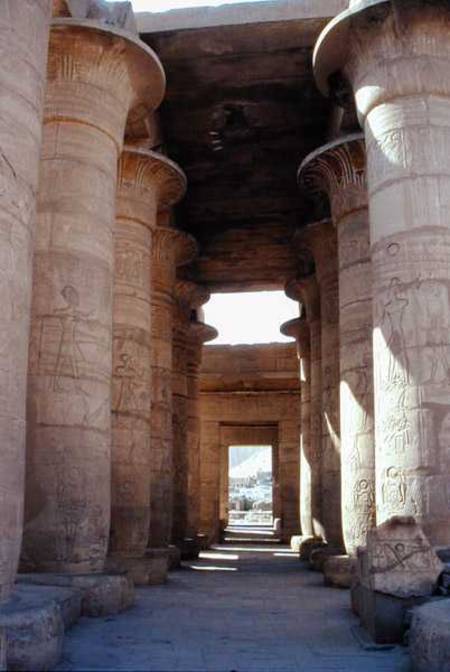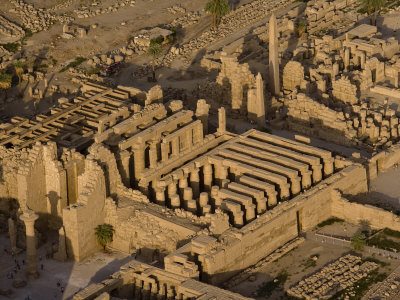Beyond the Hypostyle Hall and a few pillars once stood two obelisks. Obelisks are tall, thin pillars that stand on their own. A good example of a modern obelisk would be the Washington Monument in Washington D.C. Egyptians were the first to create obelisks. Their reason for creating obelisks is the same reason they do anything, to honor the god Amun-Re. Originally Egyptians built pyramids to symbolize a ben-ben stone, and to put the ben-ben stone at the top closer to the gods, so when they died they could go out of the ben-ben stone and ride their boats into the sky where the gods were. After they quit building pyramids they began building sun temples, which were similar to pyramids, only kings were not buried in them. After sun temples, they began building obelisks. Obelisks did the best job of putting the obelisk into the sky and really presented best.
Originally there were two obelisks in the temple, but one of them fell. Another one was under production, but never went up. This was an important find by archaeologists because it showed them how the obelisks were built.
In my opinion, this is just another example of how smart these Egyptians were. They were always finding better ways to express what they wanted to. Everything they did was also very detailed. The obelisks are full of artwork that at the time it was built was fully painted and beautifully crafted. I am always amazed at how well thought everything they do is and how much time they dedicate to their God's.
Work Cited
http://en.wikipedia.org/wiki/Karnak
Wednesday, February 29, 2012
Thursday, February 16, 2012
Hypostyle Hall
One of the largest features in the Temple of Amun at Karnak is the Hypostyle Hall. A Hypostyle Hall is a hall full of columns. However, in ancient they held much deeper meaning than that. To understand the meaning of the Hypostyle Hall you must understand Egyptian religion and creation mythology to an extent. In the eyes of the Egyptian royalty, Amun was the most important God. He was the creator God. The one who was responsible fore creating their land. The story of creation is that Amun rose from a muddy abyss in the middle of a swamp onto a mound, known as a ben-ben stone. As he rose, he created life. Inside temples of Amun you would always find a mound, that represented the mound in which he created the world, but that is not what is important to the Hypostyle Hall. The importance of the Hypostyle Hall to the Temple of Amun is that it represents the field of reeds he came out of the ground in. These columns were designed to look like the papyrus.
To get to the creation mound in the Temple, you had to go through the Hypostyle Hall. This held much religious meaning behind it to the Egyptians. The God Amun was so important to the Egyptians, that at this particular temple, only the Chief Priest was allowed back into the room holding the mound to see the statue of the God.
I believe that the Egyptians views on their creation and the way they worshiped their Gods was really incredible. The amount of detail and time spent to create this temple alone is astonishing, especially since this temple was not a temple for the Egyptian people to go to. This temple was specifically made as a temple for the god. Only priests of Amun and Egyptian royalty were even permitted to entering the temple.
 One of many rows of columns. At one time, these were all fully painted and much more of the detail in each was prevalent.
One of many rows of columns. At one time, these were all fully painted and much more of the detail in each was prevalent.
 As you can see, upon passing through the main entrance, the Hypostyle Hall is the second large area you enter.
As you can see, upon passing through the main entrance, the Hypostyle Hall is the second large area you enter.
Work Cited
http://www.bible-history.com/past/images/temple_of_amun_karnak9.gif
http://en.wikipedia.org/wiki/Great_Hypostyle_Hall
http://www.myartprints.co.uk/a/egyptian/columns-with-papyrus-shaf.html
To get to the creation mound in the Temple, you had to go through the Hypostyle Hall. This held much religious meaning behind it to the Egyptians. The God Amun was so important to the Egyptians, that at this particular temple, only the Chief Priest was allowed back into the room holding the mound to see the statue of the God.
I believe that the Egyptians views on their creation and the way they worshiped their Gods was really incredible. The amount of detail and time spent to create this temple alone is astonishing, especially since this temple was not a temple for the Egyptian people to go to. This temple was specifically made as a temple for the god. Only priests of Amun and Egyptian royalty were even permitted to entering the temple.
 One of many rows of columns. At one time, these were all fully painted and much more of the detail in each was prevalent.
One of many rows of columns. At one time, these were all fully painted and much more of the detail in each was prevalent. As you can see, upon passing through the main entrance, the Hypostyle Hall is the second large area you enter.
As you can see, upon passing through the main entrance, the Hypostyle Hall is the second large area you enter.Work Cited
http://www.bible-history.com/past/images/temple_of_amun_karnak9.gif
http://en.wikipedia.org/wiki/Great_Hypostyle_Hall
http://www.myartprints.co.uk/a/egyptian/columns-with-papyrus-shaf.html
Thursday, February 2, 2012
Introduction
The Temple of Amun at Karnak was a giant temple dedicated to the creator God. The temple was under continuous construction for over 2000 years as almost every King in Egyptian history from the twelfth dynasty on built on it. There are many levels to the temple that are separated by pylons.
The amount added to the temple differed from king to king, but Rameses II built more than anyone there. He added the most popular part of the temple, which is the Hypostyle Hall. Other famous features are the pylons, the open air sun temple, the obelisks and the giant statues at the front of the temple of Rameses and his Queen.
While most of this giant temple discovered, there is still more being unearthed by archaeologists. One of the more interesting things that they have recently discovered is road of over two miles connecting the Temple at Karnak and the Temple at Luxor. This road is lined with criosphinxes on both sides.


More information can be found at: http://www.bluffton.edu/~sullivanm/egypt/karnak/karnak.html
The amount added to the temple differed from king to king, but Rameses II built more than anyone there. He added the most popular part of the temple, which is the Hypostyle Hall. Other famous features are the pylons, the open air sun temple, the obelisks and the giant statues at the front of the temple of Rameses and his Queen.
While most of this giant temple discovered, there is still more being unearthed by archaeologists. One of the more interesting things that they have recently discovered is road of over two miles connecting the Temple at Karnak and the Temple at Luxor. This road is lined with criosphinxes on both sides.


More information can be found at: http://www.bluffton.edu/~sullivanm/egypt/karnak/karnak.html
Subscribe to:
Posts (Atom)
